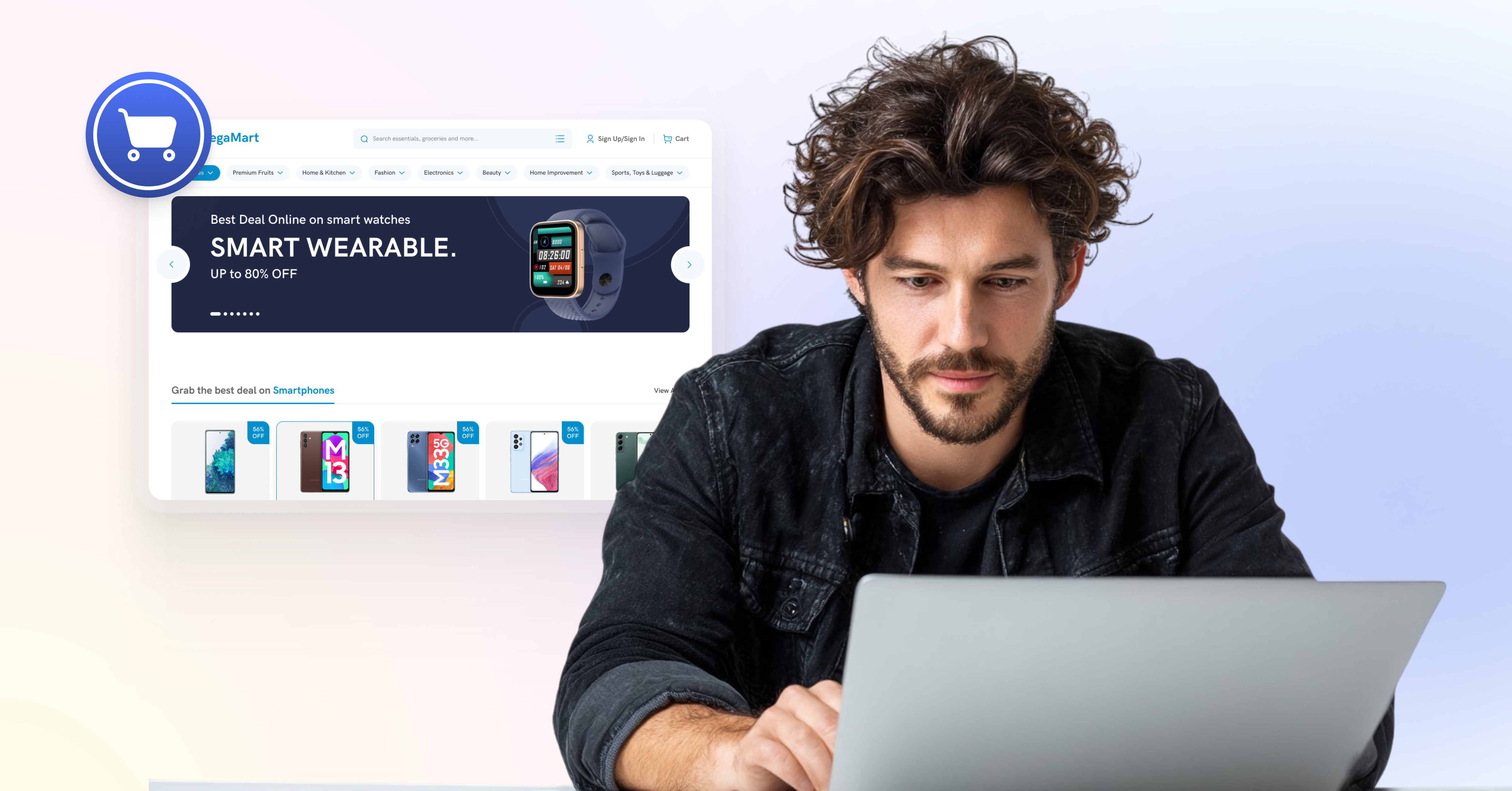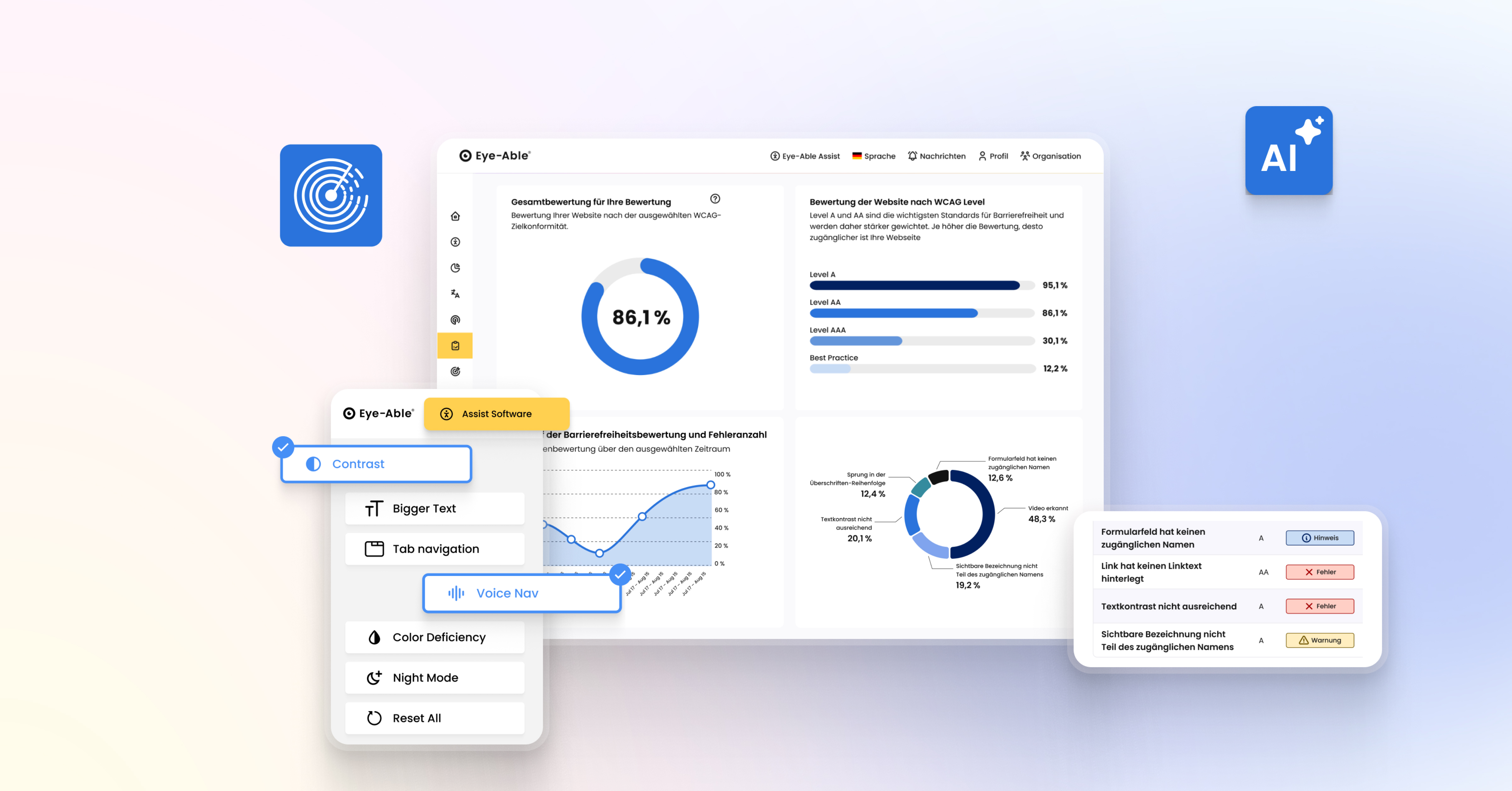How to make your online shop accessible: requirements, advantages, and implementation tips
Why an accessible online shop is indispensable today
Only one-third of German online shops are currently fully accessible.
People with disabilities navigate websites differently; some need a screen reader, others need voice or keyboard control, Braille displays, or a joystick. For this reason, it is necessary to make your online shop accessible, taking into account legal, technical, and design aspects. The goal: to expand your customer base and offer digital inclusion.
What does accessibility mean in e-commerce?
Digital accessibility enables accessibility for all users, regardless of any disabilities they may have.
Imagine a shopping street full of stores, one of which is your office supply store. A man in a wheelchair wants to buy several items of stationery in your store, but there are three steps that make access impossible for him. There is no ramp, and no one helps him. Frustrated, he turns around and buys from one of your competitors. The same thing could happen to your online store: people with disabilities or temporary limitations could switch to your competitors if you do not provide them with barrier-free access.
The goal of digital accessibility is to enable all people to access your online store without barriers or the help of third parties. This includes accessible HTML code, a content strategy for understandable texts, clear navigation, high-contrast design of all website content, and the provision of alternative audiovisual content, for example for images. Responsive design, i.e., adapting web content to users' devices, is equally important. The ability to navigate using a keyboard also plays a major role. The use of assistive technologies, such as screen readers, must be enabled. Low-threshold access through a clear page structure and the use of simple language is also essential.
Read more about e-commerce in connection with Eye-Able® here.
Which target groups need accessible online shops?
All people who have a temporary or permanent disability and who also fit into the company's target group need an accessible online shop.
This includes, among others:
People with cognitive, visual, motor, or auditory impairments
Users with low digital literacy
People with learning difficulties
People with temporary motor impairments
People with visual impairments have difficulty recognizing text, buttons, or form fields if they do not contrast clearly with the background. Blind people cannot navigate websites where images, forms, or buttons are not correctly labeled. Deaf and hard-of-hearing people cannot properly understand videos without subtitles.
In June 2025, Aktion Mensch and Google published a test report showing that 61% of people with disabilities shop primarily online, compared to only 51% of people without disabilities.
Legal requirements for accessibility in online shops
There are various laws that regulate digital accessibility in Germany.
Accessibility & online shops: Legal requirements
Online shops are obliged to ensure digital accessibility. The basis for this is the European Accessibility Act (EAA), which corresponds to the EU Accessibility Directive. In Germany, the EAA is implemented by the Accessibility Enhancement Act (BFSG). For more information, see our blog post The EAA 2025: That`s what matters!
According to Section 12 of the Accessibility Enhancement Act (BFSGV), online shops must be appropriately perceivable, operable, understandable, and robust (in terms of stability). According to Section 13 BFSGV, online shops must have basic functions that are geared towards the different needs of people with disabilities and enable the use of the website with assistive technologies.
So-called micro-enterprises are an exception. These include companies with less than €2 million in annual turnover and fewer than 10 employees. However, if the shop sells products that fall within the scope of the BFSG, it must still be accessible. You can find out more about this in our blog post Accessibility statements explained in an understandable way: content, obligations, examples
Online shops in the B2B sector are another exception, but these must be clearly identified as such and may only target businesses. So-called dormant shops that are used as archives and have not generated any sales since June 29, 2025, are also exempt. Please note: Individual “dormant” subpages are not exempt if the online shop is still active in general.
Since when has this obligation applied to online shops, and what happens in the event of a violation?
The obligation has been in force since June 28, 2025, since when the BFSG has also stipulated an accessibility obligation for private companies. It applies to products and services that have been offered since then.
Violations of digital accessibility may result in warnings from consumer protection organizations or competitors. Fines of up to €100,000 are possible under Section 29 BFSG. Market surveillance authorities can order the removal of existing barriers and set a deadline. If this is not met, further sanctions will be imposed and, in the worst case, a ban on the sale or provision of the service will be imposed.
People with disabilities can take civil action against non-accessible websites, which can lead to enormous damage to reputation. In addition, there is a risk of high sales losses and costs due to subsequent website improvements. Negative publicity can cause lasting damage to a company's image, resulting in customers losing confidence in the brand.
Which areas of the online shop must be accessible?
Intuitive usability, easily understandable content, and technical implementation that is compatible with assistive technologies are crucial. People navigating the site need a smooth process from start to finish, from product search to payment:
Navigation is important, and a clear structure is necessary that can be operated with both a keyboard and a screen reader.
Product descriptions must be accessible and easy to read.
Documents, such as PDFs, must be accessible.
The payment process must be completely accessible so as not to jeopardize the transaction by causing users to leave the site prematurely.
The consent banner, which appears as a window as soon as a website is opened, provides information about the use of cookies. As the first point of contact with the online shop, it should also be accessible.

How to make your online shop accessible
Eye-Able® shows you step by step how to make your online shop accessible.
Technical measures for greater accessibility
A basic requirement is the use of semantically correct HTML code, for example, to display headings correctly. Alternative texts for images, known as alt tags, should be set. These are important for people with visual impairments or blind people. Multimedia content must be optionally hideable, pausable, or stoppable. All functions on the website should be operable via keyboard. Form fields that need to be filled in require understandable labels and, if necessary, explanations. Interactive elements should be readable by assistive technologies, for example menus or clickable areas. Media, documents, and forms must also be accessible.
Design tips for better user-friendliness
The following are essential for barrier-free design of your website:
A clear and unambiguous page structure, navigation, and focus indicators
The use of a responsive design for mobile use
Customizable text sizes and spacing
The use of easily readable fonts and a minimum size of 16px, ideally a size of 18-20px in body text
high contrast between text and background as well as on images and graphics
no flashing or animated content
a consistent, recognizable design
The technical measures only work in conjunction with the design tips to implement an accessible website. The clearer and more accessible a website is, the longer visitors stay and the higher customer satisfaction is.
Accessible design therefore plays an important role. You can find in-depth information on this topic in our blog post of the same name. (LINK here)
Advantages of solutions such as Eye-Able®
A solution that supports the implementation of an accessible website offers many advantages. Eye-Able® helps website users to independently adjust various settings. These include contrast adjustments, text enlargement, image hiding, read-aloud functions, various filters, and color blindness compensation. Users can save individual adjustments as instant views.

The Eye-Able® platform complements technical measures in a meaningful way and offers a comprehensive, high-quality user experience. The individual needs of each person on the website are taken into account and accessibility is implemented directly.
The integration of individual steps on the path to accessibility and maintenance reduces the burden on website operators.
Ensuring long-term accessibility: maintenance and updates
Regular testing and adjustments during design or system updates are particularly important for website maintenance. Feedback from users can be taken into account and implemented.
Thanks to a monitoring function such as the one in the Eye-Able® solution, website operators can respond quickly and without delay to any vulnerabilities that may exist.
Advantages of accessible online shops for operators and customers
A survey on accessibility in 11 countries conducted by the software company Capterra found that 74% of the companies surveyed believe they have lost orders in the past due to a lack of accessibility. Accessibility enables companies to strengthen customer loyalty, reach a larger target group, and improve their image on social media.
More sales through better accessibility
An accessible online shop can expand existing target groups, which forms the basis for higher sales. A deeper connection with customers is created through a user experience that is perceived as positive and inclusive. Bounce rates and associated abandoned purchases are reduced, which also increases sales.
Better SEO through digital accessibility
There is overlap between the accessibility of a website and the SEO goals of the company. Accessible implementation improves SEO, so that the website is better ranked by search engines.
A clear HTML structure improves visibility, making your online shop easier to find. Search engines can be supported by text alternatives and speaking URLs, thereby strengthening the website.
A long dwell time and strong user-friendliness send signals to search engines that this is a relevant website. Optimized accessibility of images or videos provides increased text context to the search engine. Accordingly, an accessible page leads to more organic traffic through increased visibility and better rankings in search engines.

Search engines do not penalize inaccessible websites. The consequences: Even people without disabilities find it difficult to find your site.
Higher conversion rates through an inclusive user experience
The conversion rate indicates how many people on the website perform an action desired by the company, such as buying something in the online store. It improves the more inclusive the user experience on the website is. Intuitive website navigation has a particularly positive effect on the entire payment process, reducing the number of abandoned purchases.
The target groups' trust is strengthened by the accessible and user-friendly design. The brand benefits from an inclusive experience, which results in a more positive image.
Practical examples & solutions: How shops implement accessibility
There are many positive examples that give you a first impression of successful implementation.
Comparison of successful accessible online shops
Numerous online shops already rely on Eye-Able®, for example Babor, Diashop, and Frankonia.
Babor, a luxury cosmetics retailer, stands out for its accessible process from product search to checkout. Babor considers digital accessibility a matter of course and does not use it for marketing purposes.
In its accessibility statement, Diashop, a specialist retailer and mail order company for diabetes supplies, discloses which areas of the online shop are already accessible in a legally compliant and user-friendly manner. It is particularly commendable that Diashop also mentions which barriers it intends to adjust in the future. There is also the option to report barriers.
Frankonia, an online shop for hunting, shooting sports, and outdoor fashion, also offers a comprehensive accessibility statement. Divided according to the WCAG, there is a precise indication for each area of how digital accessibility is implemented in the online shop. There is also the option to report barriers.
A combination of good usability, well-thought-out technology, compatibility, and an appealing design brings the best results for a successful online shop.
What are the advantages of solutions such as Eye-Able®?
Eye-Able® can be quickly integrated into your website, is GDPR-compliant, and offers the option of adding backend measures. Users can customize settings, such as color modes or font sizes. As a platform-independent solution, Eye-Able® can be quickly and easily integrated into all common CRM systems and makes it easier for you to create an accessible online store.
This allows you to leverage sales potential, strengthen customer loyalty, and avoid legal consequences. Accessibility improves the user experience for all visitors and increases your visibility in search engines.
FAQ
What is an accessible online store?
A store that is accessible to everyone and as easy to use as possible. Barriers for people with disabilities are avoided.
How can I test whether my website is accessible?
Take the free test with Eye-Able®.
What criteria make an online store accessible?
Structured navigation, easy keyboard operation, alternative content, easy-to-understand language, and accessible access to documents.
How do I make my online shop accessible?
It is important to conduct a comprehensive analysis of the current situation, follow a structured process for implementing individual steps, make technical adjustments, optimize the design, and carry out tests. The content must be regularly adapted and maintained. The Eye-Able® platform solution can help you with this.
How much does it cost to make an online shop accessible?
The exact costs depend on the size of the online shop and its complexity. The current level of accessibility is also a decisive factor. Tools such as Eye-Able® reduce the effort involved.
Since when do online shops have to be accessible?
According to the BFSG, online shops must be accessible since June 28, 2025.
Check your website's accessibility for free with Eye-Able®!
)